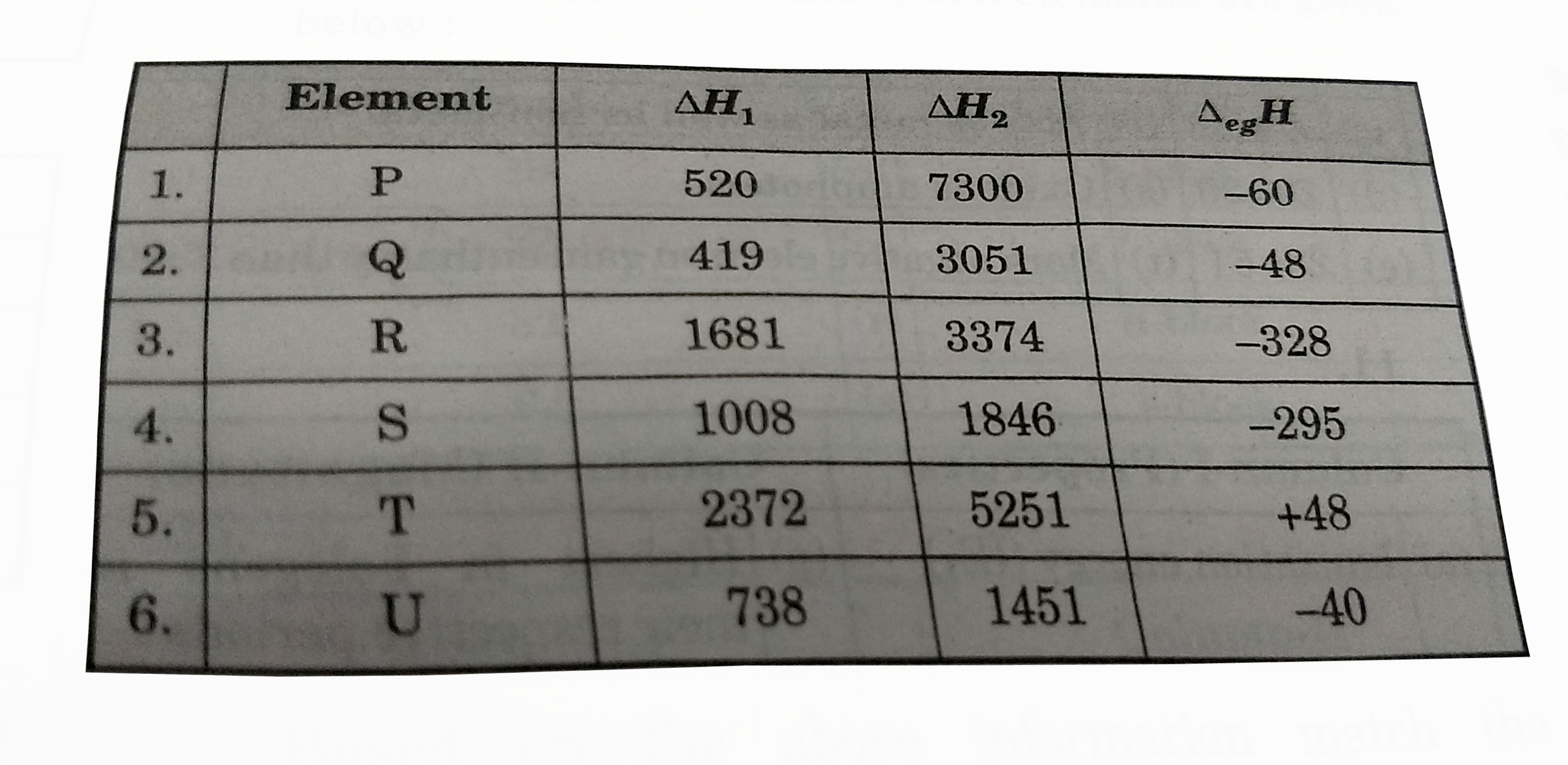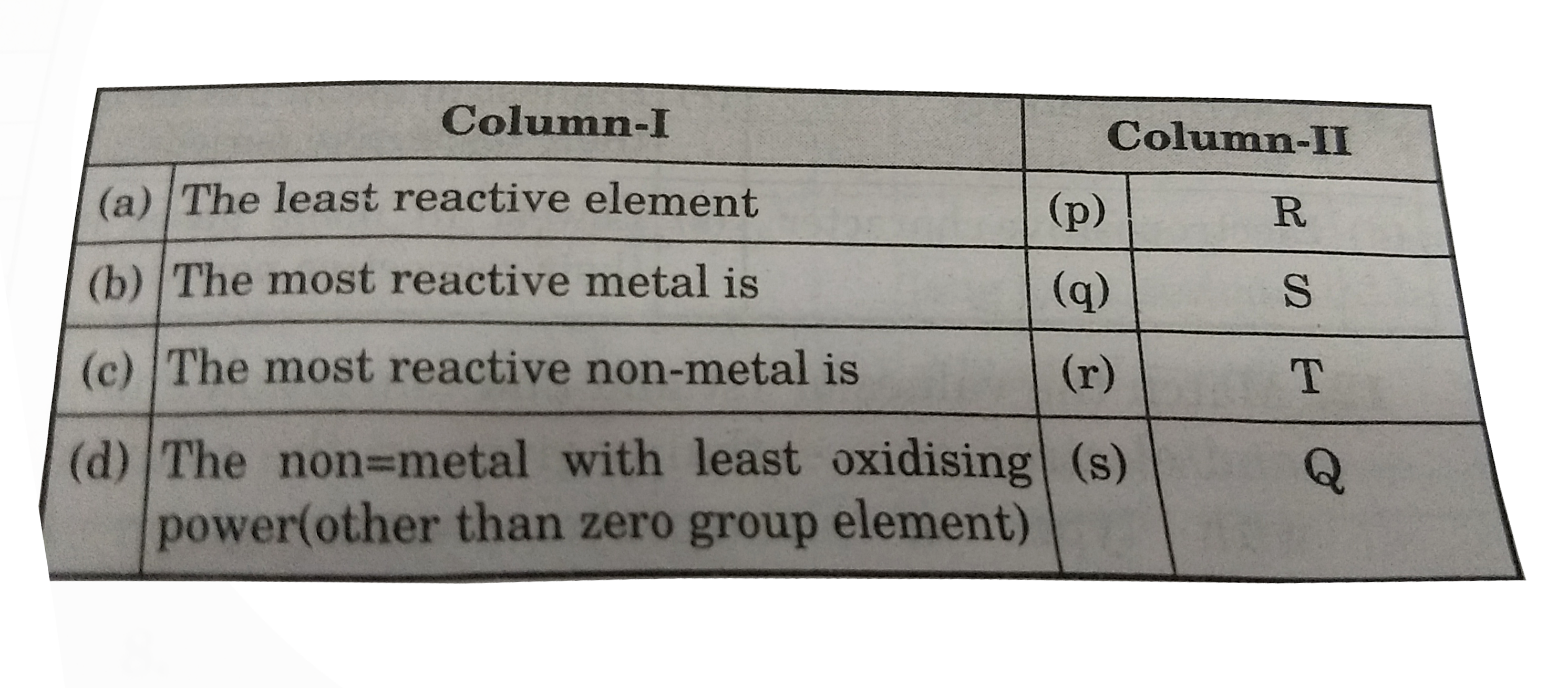The first (ΔiH1) and second (ΔiH2) ionisation enthalpies (inkJmol−1) and the (ΔegHө) electron gain enthalpy (inkJmol−1) of a few elements are given below:
Elements(ΔiH1)(ΔiH2)ΔegHөI5207300−60II4193051−48III16813374−328IV10081846−295V23725251+48VI7381451−40
Which of the above elements is likely to be
a. the least reactive element.
b. the most reactive metal.
c. the most reactive non-metal.
d. the least reactive non-metal.
e. the metal which can form a stable binary halide of the formula MX2 (X=halogen).
f. the metal which can form a predominantly stable covalent halide of the formula MX(X=halogen).
R
S
P
U
The correct Answer is:A
Non-metal having higher negative value of electron gain enthalpy corresponds to halogen.Hence R is more reactive non-metal (easily forms anion)
Topper's Solved these Questions
Similar Questions
The first (ΔiH1) and second (ΔiH2) ionisation enthalpies (inkJmol−1) and the (Delta_(eg)H^(ө)) electron gain enthalpy (inkJmol−1) of a few elements are given below:
Elements(ΔiH1)(ΔiH2)ΔegHөI5207300−60II4193051−48III16813374−328IV10081846−295V23725251+48VI7381451−40
Which of the above elements is likely to be
a. the least reactive element.
b. the most reactive metal.
c. the most reactive non-metal.
d. the least reactive non-metal.
e. the metal which can form a stable binary halide of the formula MX2 (X=halogen).
f. the metal which can form a predominantly stable covalent halide of the formula MX(X=halogen).View SolutionThe first (ΔH1) and second (ΔH2) ionisation enthalpies (in kJmol−1) and the (ΔHeg) electron gain enthalpy (in kJmol−1) of a elements are given below:

Based on the above information match the following columns.
 View Solution
View Solution
Knowledge Check
- Question 1 - Select One
The first (ΔIH1) and second (ΔIH2) ionisation enthalpies (in kJ mol−1) and the (ΔegH) electron gain enthalpy (in kJ mol−1) of a few elements are given below:

The least reactive element is :APBQCRDT - Question 2 - Select One
The first (ΔiH1 and second (ΔiH2 ionization enthalpies (in kJ/mol) and electron gain enthalpy (in kJ/mol) of few elements are given below:
ElementsΔiH1ΔiH2ΔegHI5207300−60II16813374−328III8991757+48IV23725251+48
Which of the above is likely to be He:AIBIICIIIDIV - Question 3 - Select One
The first (ΔiH1 and second (ΔiH2 ionization enthalpies (in kJ/mol) and electron gain enthalpy (in kJ/mol) of few elements are given below:
ElementsΔiH1ΔiH2ΔegHI5207300−60II16813374−328III8991757+48IV23725251+48
Which of the following is likely to be an alkali metal?AIBIICIIIDIV
The first (IE1) and second (IE2) ionisation energies (kJmol−1) of a new element designated by roman numericals are shown below:
(IE1)(IE2)I23725251II5207300III9001760IV16803380
Which of these elements is likely to be (a) a reactive metal, (b) a reactive non-metal, (c) a noble gas and (d) a metal that forms a binary halide of the formula, AX2.View SolutionThe first (IE1) and the second (IE2) ionization enthalpies (kJ mol−1) of a few elements designated by Roman numerals are shown below:
ElementIE1IE2I23725251II5207300III9001760III9001760IV16803380
Which of the above elements is likely to be a,
reactive non metalView SolutionThe first (IE1) and the second (IE2) ionization enthalpies (kJ mol−1) of a few elements designated by Roman numerals are shown below:
ElementIE1IE2I23725251II5207300III9001760III9001760IV16803380
Which of the above elements is likely to be a,
reactive non metalView SolutionThe first (IE1) and the second (IE2) ionization enthalpies (kJ mol−1) of a few elements designated by Roman numerals are shown below:
ElementIE1IE2I23725251II5207300III9001760III9001760IV16803380
Which of the above elements is likely to be a,
reactive metalView SolutionThe first (ΔiH1) and second (ΔiH2) ionization enthalpies (in kJ mol−1) and the electron gain enthalpy (ΔegH)(in kJ mol−1) of the elements I, II, III, IV and V are given below

the least reactive non - metal and the most reactive metal of these are respectivelyView Solution
